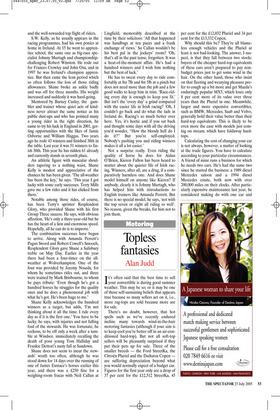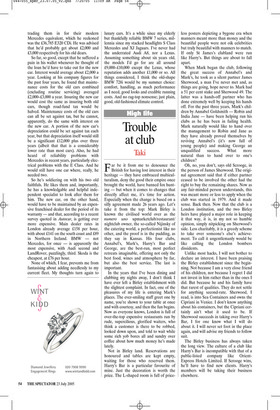Topless fantasies
Alan Judd
It’s often said that the best time to sell your convertible is during good summer weather. This may be so; or it may be one of those self-sustaining beliefs that appears true because so many sellers act on it, i.e., more rag-tops are sold because more are for sale.
There’s no doubt, however, that hot spells such as we’ve recently endured incline many towards wind-in-the-hair motoring fantasies (although if your aim is to keep cool you’re better off in an air-conditioned hard-top). But not all soft-top sellers will be pleasantly surprised if they put their pets up for sale. Three of the smaller breeds — the Ford StreetKa, the Citroën Pluriel and the Daihatsu Copen are suffering depreciation beyond what you would normally expect of a budget car. Figures for the first year only are a drop of 37 per cent for the £12,512 StreetKa, 45 per cent for the £12,032 Pluriel and 34 per cent for the £13,332 Copen.
Why should this be? They’re all blameless enough vehicles and the Pluriel at least is not bad-looking. The answer, I suspect, is that they fall between two stools: buyers of the cheaper hard-top equivalents of these cars aren’t prepared to pay nonbudget prices just to get some wind in the hair. On the other hand, those who insist on that fleeting and wearying pleasure prefer to cough up a bit more and get Mazda’s enduringly popular MX5, which loses only 8 per cent more of its value over three years than the Pluriel in one. Meanwhile, larger and more expensive convertibles, such as BMW, Mercedes, Saab and Volvo, generally hold their value better than their hard-top equivalents. This is likely to be even more the case with models just coming on stream, which have foldaway hardtops.
Calculating the cost of changing your car is not always, however, a matter of looking at the trade figures. You have to calculate according to your particular circumstances. A friend of mine runs a business for which he needs two cars. He’s had the same two since he started the business: a 1989 diesel Mercedes saloon and a 1994 diesel Mercedes estate, both now with over 200,000 miles on their clocks. After particularly expensive maintenance last year, he considered making do with one car and trading them in for their modern Mercedes equivalent, which he reckoned was the £36,785 E320 CDi. He was advised that he’d probably get about £2,000 and £3,000 respectively for his old dears.
So far, so good, except that he suffered a pain in his wallet whenever he thought of the loan he’d have to take out for the new car. Interest would average about £2,000 a year. Looking at his company figures for the past four years, he found that maintenance costs for the old cars combined (excluding routine servicing) averaged £2,000–£3,000 a year. Insuring the new car would cost the same as insuring both old cars, though road-fund tax would be halved. Maintenance costs of the old cars can all be set against tax, but he cannot, apparently, do the same with interest on the new car. A portion of the new car’s depreciation could be set against tax each year, but that depreciation itself would still be a significant £12,000 plus over three years (albeit that that is a considerably lower rate than most cars). Also, he had heard of reliability problems with Mercedes in recent years, particularly electrical problems with the E Class. And he would still have one car where, really, he needed two.
So he’s soldiering on with his two old faithfuls. He likes them and, importantly, he has a knowledgable and helpful independent specialist to look after them for him. The new car, on the other hand, would have to be maintained by an expensive franchised dealer for the period of its warranty — and that, according to a recent survey quoted in Autocar, is getting ever more expensive. Main dealer rates in London already average £158 per hour, with about £141 on the south coast and £89 in Northern Ireland. BMW — not Mercedes, for once — is apparently the most expensive, with Audi second and LandRover, puzzlingly, third. Skoda is the cheapest, at £76 per hour.
None of which, I fear, prevents me from fantasising about adding needlessly to my current fleet. My thoughts turn again to luxury cars. It’s a while since my elderly but thankfully reliable BMW 7 series, millennia since my stacked headlights S Class Mercedes and XJ Jaguars. I’ve never had the underrated Audi A8, nor a Lexus. Assuming something about six years old, the models I’d go for are all around £9,000–£10,000 except the Lexus, whose reputation adds another £1,000 or so. All things considered, I think the old-shape BMW 728i would be my summer choice: comfort, handling, as much performance as I need, good looks and credible running costs. And no rag-top nonsense; just plain, good, old-fashioned climate control.
















































 Previous page
Previous page